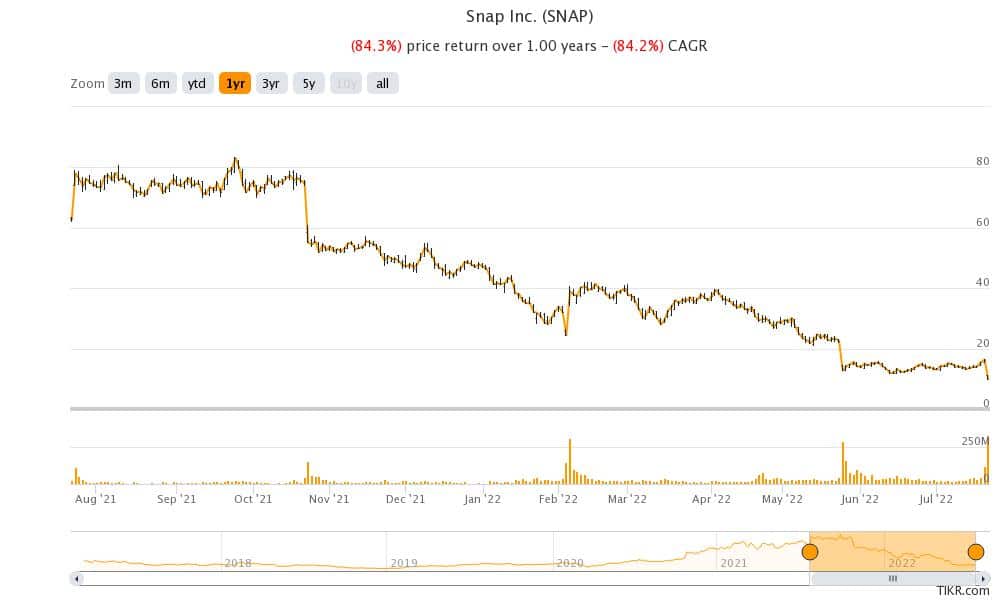
Snap released its earnings on Thursday after the markets closed. The shares fell over 39% on Friday and fell to a new 52-week low of $9.91 before eventually closing at $9.96. There was a widespread sell-off in social media shares and they collectively lost $80 billion in market cap in a single day.
There is a sense of déjà vu here. In May, Snap said that it won’t be able to meet its second-quarter guidance. The announcement then led to a crash in social media and digital advertising shares and they lost around $200 billion, with Facebook parent Meta Platforms alone losing $53 billion in market cap. Meta Platforms is among the top S&P 500 losers this year.
Snap earnings: Key takeaways
Snap’s revenues increased 13% to $1.11 billion in the second quarter which was only a tad short of the $1.14 billion that analysts were expecting. Its net loss however swelled to $422 million, which was almost a three-fold increase from the $152 million that it posted in the second quarter of 2021. It posted a per-share loss of 2 cents while analysts expected the metric at 1 cent. While the company posted a positive adjusted EBITDA of $7 million in the quarter, its free cash flows were -$147 million.
One silver lining in the company’s earnings release was the increase in DAUs (daily active users) which rose 18% YoY to 347 million and were ahead of the 343.2 million that analysts expected. It said that its DAUs increased in North America, Europe, as well as the rest of the world. However, the strong DAU increase wasn’t enough to offset the commentary on the outlook.
Outlook looks worrying
During the earnings call, Snap CFO Derek Anderson said, “We have seen a pretty good deceleration over the last 90 days.” He added, “Specifically, advertising spending in particular, auction-driven direct response advertising is among the very few line items in a company’s cost structure that they can reduce immediately in response to pressure on their top line or their input costs. As a result, as many industries and verticals have come under top line or input cost pressure, advertising spending has been amongst the first areas impacted.”
The company did not provide guidance for the third quarter citing uncertainty but said that the revenue run rate so far is similar to the corresponding quarter last year. Analysts were expecting an 18% yearly rise in Snap’s third-quarter revenues. Notably, between 2018 and 2021, the company’s revenues increased at a CAGR of 50%.
Snap is witnessing a slowdown
Snap blamed several factors for the slowing growth. It said, “Platform policy changes have upended more than a decade of advertising industry standards, and macroeconomic challenges have disrupted many of the industry segments that have been most critical to the growing demand for our advertising solutions.” Notably, Apple amended its iPhone privacy rules which have led to lower revenues for companies like Snap and Facebook. Meta Platforms estimates that the iPhone privacy rules would lower its 2022 revenues by almost $10 billion.
Snap also said that the ad industry’s growth has slowed down while competition has increased. Incidentally, even Netflix is launching an ad-supported tier and has partnered with Microsoft.
What is Snap doing to revive the growth?
Snap is working to revive its growth in the long term and achieve cash flow break even. It highlighted three priorities. In the shareholder letter it said “First, we will continue to invest in our products and platforms to sustain the growth of our community. Second, we will invest heavily in our direct-response advertising business to deliver measurable returns on advertising spending. Lastly, we will cultivate new sources of revenue that will help diversify our top-line growth to build a more resilient business.”
Wall Street gets bearish
Meanwhile, after the earnings release, Snap got a series of downgrades from analysts. Rohit Kulkarni of MKM Partners said that Snap is “going through a near-death experience.” Oppenheimer downgraded the shares to perform and removed the $22 target price.
It said, “In our opinion, SNAP is now facing too many headwinds for investors to underwrite stock in the medium-term—TikTok, SKAdnetwork 4.0 & rise of Retail Media Networks —before we factor in slower consumer spending in 4Q and 1H:23.”
KeyBanc also downgraded the shares from outperform to market perform pointing to increasing competition. Atlantic Equities downgraded Snap shares to neutral and lowered the target price to $13. It said, “management commentary suggests competition may be a greater than appreciated factor and more work may be required to improve Snap’s direct response offerings.”
Social media companies face troubles
Stifel also downgraded the shares to hold. While it is still bullish on the company’s long-term growth trajectory, it is apprehensive about the current macro environment. Rising inflation, slowing consumer spending, and geopolitical tensions have prompted advertisers to cut back on their ad spending which is hurting social media companies.
Markets would get more insights into the sector’s health when Meta Platforms and Alphabet report their earnings next week. The signs of stress are already visible though, with leading US tech companies cutting down on hiring amid slowing growth.


Question & Answers (0)